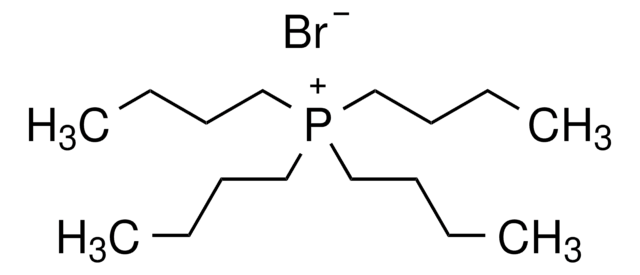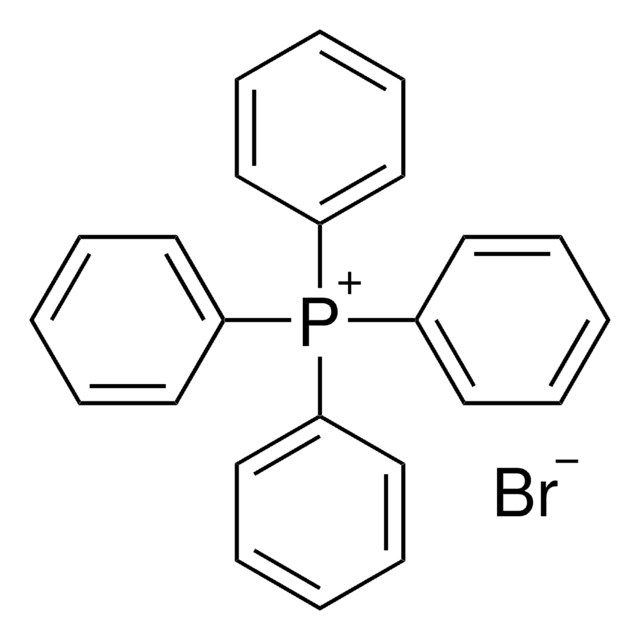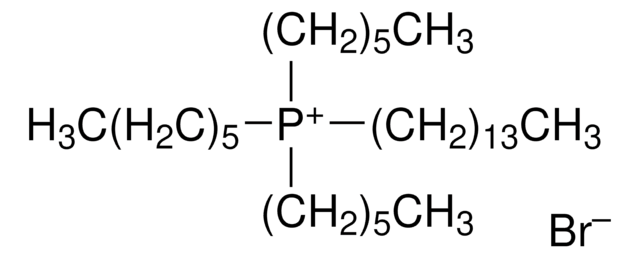144800
Tetrabutylphosphonium chloride
96%
Sinónimos:
Tetra-n-butylphosphonium chloride
About This Item
Productos recomendados
assay
96%
form
liquid
greener alternative product characteristics
Catalysis
Learn more about the Principles of Green Chemistry.
sustainability
Greener Alternative Product
mp
62-66 °C (dec.) (lit.)
greener alternative category
SMILES string
[Cl-].CCCC[P+](CCCC)(CCCC)CCCC
InChI
1S/C16H36P.ClH/c1-5-9-13-17(14-10-6-2,15-11-7-3)16-12-8-4;/h5-16H2,1-4H3;1H/q+1;/p-1
InChI key
IBWGNZVCJVLSHB-UHFFFAOYSA-M
¿Está buscando productos similares? Visita Guía de comparación de productos
Categorías relacionadas
General description
Application
- Insight into Cellulose Dissolution with the Tetrabutylphosphonium Chloride-Water Mixture using Molecular Dynamics Simulations.: This study investigates the molecular dynamics of cellulose dissolution in a Tetrabutylphosphonium chloride-water mixture, providing insights into its potential application in biomass processing and material science (Crawford and Ismail, 2020).
- Thermodynamic and Transport Properties of Tetrabutylphosphonium Hydroxide and Tetrabutylphosphonium Chloride-Water Mixtures via Molecular Dynamics Simulation.: The research focuses on the thermodynamic and transport properties of Tetrabutylphosphonium chloride in water mixtures, highlighting its relevance in developing advanced ionic liquids for various industrial applications (Crawford and Ismail, 2020).
- End-of-life Treatment of Poly(vinyl chloride) and Chlorinated Polyethylene by Dehydrochlorination in Ionic Liquids.: This article explores the use of Tetrabutylphosphonium chloride as an ionic liquid for the dehydrochlorination of PVC and CPE, demonstrating its utility in sustainable polymer recycling processes (Glas et al., 2014).
signalword
Danger
Hazard Classifications
Acute Tox. 1 Inhalation - Acute Tox. 3 Dermal - Acute Tox. 4 Oral - Aquatic Chronic 2 - Eye Dam. 1 - Skin Corr. 1C - Skin Sens. 1B
Storage Class
6.1A - Combustible acute toxic Cat. 1 and 2 / very toxic hazardous materials
wgk_germany
WGK 3
flash_point_f
>266.0 °F - closed cup
flash_point_c
> 130 °C - closed cup
ppe
Eyeshields, Faceshields, Gloves, type P3 (EN 143) respirator cartridges
Elija entre una de las versiones más recientes:
¿Ya tiene este producto?
Encuentre la documentación para los productos que ha comprado recientemente en la Biblioteca de documentos.
Nuestro equipo de científicos tiene experiencia en todas las áreas de investigación: Ciencias de la vida, Ciencia de los materiales, Síntesis química, Cromatografía, Analítica y muchas otras.
Póngase en contacto con el Servicio técnico











